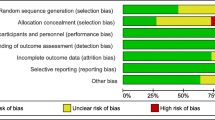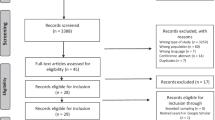Abstract
Purpose
To use conflict resolution analysis on the conflict between proponents and opponents of preimplantation genetic testing for aneuploidy (PGT-A), previously called preimplantation genetic screening (PGS).
Methods
Considered in conflict analysis a case study, we reviewed the English literature based on key-word searches at www.pubmed.com and www.google.com, and interviewed professional opinion leaders and other actor-representatives. This analysis was the product of a mandated externship by L.M. at the Foundation for Reproductive Medicine (FRM), as part of the Master of Science Program in Negotiations and Conflict Resolution at Columbia University, New York, NY.
Results
Initially a typical difference of opinion, conflict evolved after proponents rejected studies that failed to confirm expected benefits, and authors felt demeaned by their criticism. Becoming “destructive,” the conflict evolved according to Glasl’s escalation model stages. Proponents became continuous attractors. Unable to produce validations for PGT-A, proponents moved goal posts through 3 stages (PGS 1.0–PGS 3.0). Ultimately concurring that pregnancy and live birth rates are unaffected, they started claiming new benefits.
Conclusions
The FRM underwrote this study as a starting tool for a conflict resolution process. A consensus building conference of stakeholders appears as of this point to represent the most promising potential intervention. The goal of such a conference should be sustainable consensus about clinical utilization of PGS/PGT-A in IVF, based on transparent and validated criteria. A potential date for such a conference is set for 2020.

Similar content being viewed by others
References
Global Partnership for the Prevention of Armed Conflict (GPPAC). Conflict analysis framework: field guidelines and procedure. https://gppac.net/files/2018-11/GPPAC%20CAFGuide_Interactive%20version_febr2018_.pdf.
Verlinsky Y, Cieslak J, Ivakhnenko V, Evsikov S, Wolf G, White M, et al. Preimplantation diagnosis of common aneuploidies by the first and second polar body FISG analysis. J Assist Reprod Genet. 1998;15:285–9.
Staessen C, Platteau P, Van Assche E, Miciels A, Tournaye H, Camus M, et al. Comparison of blastocyst transfer with and without preimplantation genetic diagnosis for aneuploidy screening in couples with advanced maternal age: a prospective randomized controlled trial. Hum Reprod. 2004;19:2849–58.
Platteau P, Staessen C, Michiels A, Van Steirteghem A, Liebaers I, Devroey P. Preimplantation genetic diagnosis for aneuploidy screening in women older than 37 years. Fertil Steril. 2005;84:319–24.
Platteau P, Staessen C, Michiels A, van Steirteghem A, Liebaers I, Devroey P. Preimplantation genetic screening for aneuploidy screening in patients with unexplained recurrent miscarriages. Fertil Steril. 2005;83:393–7.
Gleicher N, Weghofer A, Barad D. Preimplantation genetic screening: “established” and ready for prime time? Fertil Steril. 2008;89(4):780–8.
Mastenbroek S, Twisk M, van Echten-Arends J, Sikkema-Raddatz B, Korevaar JC, Verhoeve HR, et al. In vitro fertilization with preimplantation genetic screening. N Engl J Med. 2007;357(1):9–17.
FDA, 2017. [Laboratory developed tests, U.S. Food & Drug Administration, U.S. Department of Health and Human Services, January 13, 2017, https://www.fda.gov/MedicalDevices/ProductsandMedicalProcedures/InVitroDiagnostics/LaboratoryDevelopedTests/default.htm.
Deutsch M. Conflicts: productive and destructive. J Social Issues. 1969;25:7–41.
Glasl F. The process of conflict escalation and roles of third parties. In: Bomers GBJ, et al., editors. Conflict Managment and Industrial Relations. Dordercht: Springer Science Business Media; 1982. p. 119–40.
Practice Committee of the American Society for Reproductive Medicine. Preimplantation genetic testing: a Practice Committee opinion. Feril Steril. 2008;90:S136–43.
Gleicher N, Metzger J, Croft G, Kushnir VA, Albertini DF, Barad DH. A single trophectoderm biopsy at blastocyst stage is mathematically unable to determine embryo ploidy accurately enough for clinical use. Reprod Biol Endocrinol. 2017;15(1):23.
Bolton H, Graham SJ, Van der Aa N, Kumar P, Theunis K, Fernandez Gallardo E, et al. Mouse model of chromosome mosaicism reveals lineage-specific depletion of aneuploid cells and normal developmental potential. Nat Commun. 2016;7:11165.
Rito T, Naftaly J, Gleicher N, Brivanlou A. Self-correction of aneuploidy in human blastocystsmand self-organizing gastruloids. Fertil Steril, 2019; 112 (suppl 3), e127;P49
Gleicher N, Vidali A, Braverman J, Kushnir VA, Albertini DF, Barad DH. Further evidence against use of PGS in poor prognosis patients: report of normal births after transfer of embryos reported as aneuploid. Fertil Steril 2015;104(Suppl).
Greco E, Giulia Minasi M, Florentino F. Healthy babies after intrauterine transfer of mosaic aneuploid blastocysts. N Engl J Med. 2015;373:2989–090.
Paulson RJ. Preimplantation genetic screening: what is the clinical efficiency? Fertil Steril. 2017;108(2):228–30.
PGDIS. Preimplantation Genetic Diagnosis Society (PGDIS) position statement on chromosome mosaicism and preimplantation aneuploidy testing at the blastocyst stage, Chicago, Illinois; July 19, 2016 http://pgdis.org/docs/newsletter_071816.html.
Kredo T, Bernhardsson S, Machingaidize S, Yung T, Louw Q, Ochodo E, et al. Guide to clinical practice guidelines: the current state of play. Int J Quality in Health Care. 2016;28(1):122–8.
Munné S, Blazek J, Large M, Martinez-Ortiz PA, Nisson H, Liu E, et al. Detailed investigation into the cytogenic constitution and pregnancy outcome of replacing mosaic blastocysts detected with the use of high-resolution next-generation sequencing. Fertil Steril. 2017;108(1):62–71.
Scott RT Jr, Galliano D. The challenge of embryonic mosaicism in preimplantation genetic screening. Fertil Steril. 2016;105(5):1150–2.
Munne S. Origins of mosaicism and criteria for transfer of mosaic embryos. Reprod BioMed Online. 2018;35(4):369–70.
Rosenwaks Z, Handyside AH, Fiorentino F, Gleicher N, Paulson RJ, Schattman GL, et al. The pros and cons of preimplantation genetic testing for aneuploidy: clinical and laboratory perspectives. Fertil Steril. 2018;110(3):353–61.
Hall S. Tens of thousands of women thought they couldn’t have babies. But what if they could? The abnormal embryos that aren’t. New York, 2017, p32.
Patrizio P, Shoham G, Shoham Z, Leong M, Barad DH, Gleicher N. Worldwide live births following transfer of chromosomally “abnormal” embryos after PGT/A” results of a worldwide web-based survey. 2019; doi: https://doi.org/10.1007/s10815-019-01510-0; In press
Kushnir VA, Darmon S, Albertini DF, Barad DH, Gleicher N. Degree of mosaicism in trophectoderm does not predict pregnancy potential: a corrected analysis of pregnancy outcomes following transfer of mosaic embryos. Reprod Biol Endocrinol. 2018;16(1):6.
Somigliana E, Busnelli A, Paffoni A, Vigano P, Riccaboni A, Rubio C, et al. Cost-effectiveness of preimplantation genetic testing for aneuploidy. Fertil Steril. 2019;111(6):1169–75.
Paulson RJ. Mathematics should clarify, not obfuscate: an inaccurate and misleading calculation of the cost-effectiveness of preimplantation genetic testing for aneuploidy. Fertil Steril. 2019;111(6):1113–4.
Gleicher N, Caplan AL. An alternative proposal to the destruction of abandoned human embryos. Nat Biotechnol. 2018;36(2):139–41.
Shmerling RH. First, do no harm. Harvard health Publsihing, Harvard Medical School https://www.health.harvard.edu/blog/first-do-no-harm-201510138421.
Pratto F, Sidanius J, Levin S. Social dominance theory and the dynamics of intergroup relations: taking stock and looking forward. European Rev of Social Psychology. 2006;17:271–320.
Tetlock PE. Expert political judgment. Princenton, NJ: Princeton University Press; 2005.
Xu J, Fang R, Chen L, Chen D, Xiao JP, Yang W, et al. Noninvasive chromosome screening of human embryos by genome sequencing of embryo culture medium for in vitro fertilization. Proc Natl Acad Sci U S A. 2016;113(42):11907–12.
Gleicher N, Barad DH. Not even noninvasive cell-free DNA can rescue preimplantation genetic testing. Proc Natl Acad Sci U S A. 2019. https://doi.org/10.1073/pnas.1911710116.
Practice Committees of the American Society for Reproductive Medicine and the Society for Assisted Reproductive Technology. The use of preimplantation genetic testing for aneuploidy (PGT-A): a committee opinion. Fertil Steril. 2018;109(3):429–36.
Morales R, Lledó B, Ortiz JA, Ten J, Lláce J, Bernabeu R. Embryos showing mosaicism in trophectoderm cells can achieve good pregnancy rates. Hum Reprod. 2016;31(Supl 1):i14, O–030.
Victor A, Tyndall JC, Brake AJ, Lepkowsky LT, Murphy AE, Griffin DK, et al. One hundred mosaic embryos transferred prospectively in a single clinic: exploring when and why they result in healthy pregnancies. Feril Steril. 2019;111(2):280–93.
Macklon NS, Ahuja KK, Fauser BMJM. Building and evidence base for IVF “add-ons”. Reprod BioMed Online. 2019;38(2):853–6.
Funding
This manuscript was supported by intramural funding from The Foundation for Reproductive Medicine, New York, NY.
Author information
Authors and Affiliations
Contributions
This analysis was the product of a mandated externship by L.M. at the Foundation for Reproductive Medicine (FRM), a not-for-profit research foundation in New York City, as part of the Master of Science Program in Negotiations and Conflict Resolution at Columbia University, New York, NY.
L.M., therefore, conducted the research and wrote the first draft of the manuscript. Both authors revised the manuscript and agreed on its final content.
Corresponding author
Ethics declarations
Competing interests
L.M. has no competing interests to report but has joined The CHR as a research fellow. N.G. is President of The Foundation for Reproductive Medicine in New York, NY, a not-for-profit research foundation that hosted the externship of L.M. and supported her research. N.G. is also the owner of a for-profit fertility center, The CHR in New York, NY. He is a co-inventor on several pending and already awarded US patents claiming therapeutic benefits from androgen supplementation in women with low functional ovarian reserve and relating to the FMR1 gene in diagnostic functions in female fertility. He receives royalties from Fertility Nutraceuticals, LLC, in which N.G. also holds shares. He is also a co-inventor on three pending AMH-related patent applications and in the past received research grants, travel funds, and/or speaker honoraria from Pharma and/or medical device companies, though none in any way related to hear presented materials. Neither author has commercial interests, relating to PGS/PGT-A.
Additional information
Publisher’s note
Springer Nature remains neutral with regard to jurisdictional claims in published maps and institutional affiliations.
Glossary of in this manuscript encountered conflict resolution terminology
- Accelerant
-
Person or constellation that enhances a conflict.
- Actor
-
Participant in a conflict. In accordance with their respective importance to the conflict, they are designated as primary, secondary, and tertiary actors.
- Attractor
-
Attractors are constellations of conflicts that feed intractability.
- Clusters
-
Graphic depiction of cooperating units in a conflict map.
- Conflict analysis
-
Systematic study of causes, actors, and dynamics of a conflict.
- Conflict map
-
Graphic depiction between actors in a conflict in relationship to problem(s).
- Destructive phase of a conflict
-
According to Deutsch, destructive conflicts are characterized by a tendency to expand and escalate. Whether a conflict is destructive or constructive depends on the behavior of actors. Behaviors that escalate conflicts until they develop a life of their own are considered destructive (M. Deutsch. J Social Issues 1969; 25(1):11–12).
- Glasl’s escalation model stages
-
(1) Hardening; (2) debates and polemics; (3) actions not words; (4) images and coalitions; (5) loss of face; (6) strategies of threats; (7) limited destructive blows; (8) fragmentation of the enemy; and (9) together into the abyss (Jordan T. https://www.mediate.com/articles/jordan.cfm).
- Hubs and spokes
-
Parts of a conflict map that graphically demonstrate “how things work.”
- Networks
-
When the number of actors in a conflict is high, it lends itself to a so-called network analysis.
- Stakeholders
-
Individuals who may be impacted by a conflict’s outcome.
- Sustainable consensus
-
To reach sustainable consensus it is essential for reach sustainable conflict resolution.
Rights and permissions
About this article
Cite this article
Mochizuki, L., Gleicher, N. The PGS/PGT-A controversy in IVF addressed as a formal conflict resolution analysis. J Assist Reprod Genet 37, 677–687 (2020). https://doi.org/10.1007/s10815-020-01688-8
Received:
Accepted:
Published:
Issue Date:
DOI: https://doi.org/10.1007/s10815-020-01688-8




